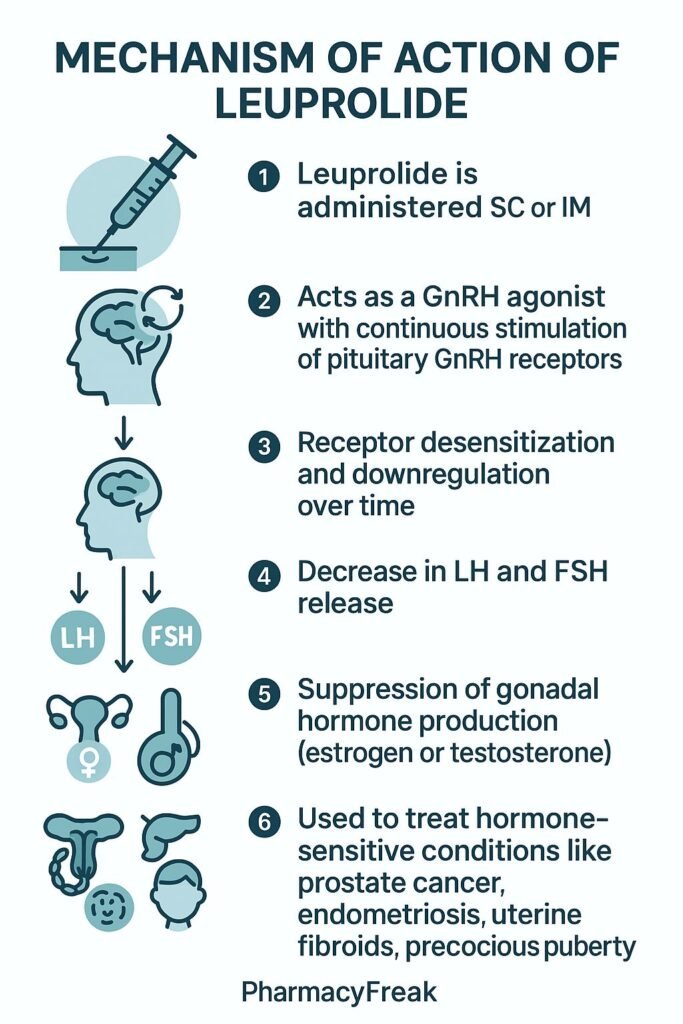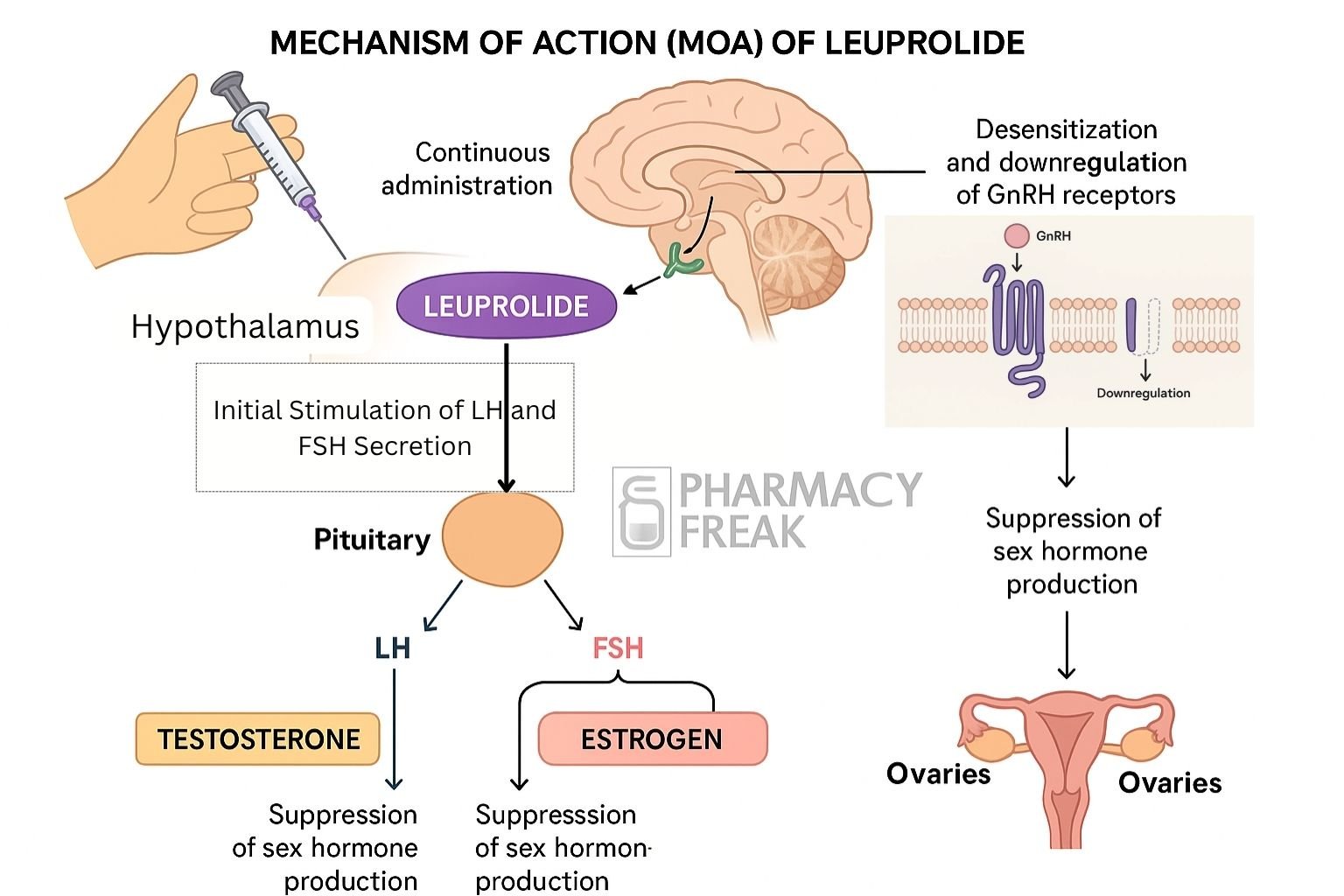Table of Contents
Introduction
Leuprolide is a synthetic gonadotropin-releasing hormone (GnRH) agonist used in conditions like prostate cancer, endometriosis, uterine fibroids, and central precocious puberty. Initially, it stimulates the pituitary gland, but with continuous use, it leads to receptor desensitization, suppressing gonadotropins and resulting in decreased sex hormone levels.

Step-by-Step Mechanism of Action
- Initial GnRH Receptor Activation
Leuprolide binds to pituitary GnRH receptors, causing a temporary surge in luteinizing hormone (LH) and follicle-stimulating hormone (FSH) — known as the “flare effect.” - Pituitary Receptor Downregulation
With continuous exposure, the receptors become desensitized and downregulated, halting further gonadotropin release. - Suppression of LH/FSH
Decreased LH and FSH production leads to reduced sex hormone synthesis (testosterone and estradiol). - Hypogonadism Effect
Sex hormone levels fall to castrate or postmenopausal levels, reducing stimulation of hormone-dependent tissues. - Therapeutic Outcomes
Alleviates symptoms and slows disease progression in hormone-sensitive conditions.

Pharmacokinetic Parameters
| Parameter | Value |
|---|---|
| Route of Administration | Subcutaneous or intramuscular injection |
| Time to Peak (Tₘₐₓ) | 1–3 hours (short-acting) |
| Half-Life | ~3 hours (immediate), longer with depot forms |
| Depot Form | 1– to 6-month formulations available |
| Protein Binding | ~45% |
| Metabolism | Peptidase degradation |
| Excretion | Primarily renal, as inactive peptides |
Clinical Uses
- Prostate cancer
- Endometriosis
- Uterine fibroids
- Central precocious puberty
- Hormonal regulation in assisted reproduction
Adverse Effects
- Flare reaction (initial testosterone/estrogen surge)
- Hot flashes
- Decreased libido
- Osteoporosis with long-term use
- Injection site reactions
- Mood swings, depression
Comparative Analysis
| Feature | Leuprolide (GnRH Agonist) | Degarelix (GnRH Antagonist) |
|---|---|---|
| Mechanism | GnRH receptor stimulation → downregulation | Direct GnRH receptor blockade |
| Flare Effect | Yes (requires antiandrogen cover) | No |
| Onset of Action | Slower (2–4 weeks) | Rapid (within days) |
| Route | Depot injection | Monthly subcutaneous injection |
| Hormone Suppression | Effective after downregulation | Immediate |
MCQs
1. Leuprolide acts on which receptor?
A. Estrogen receptor
B. GnRH receptor
C. Androgen receptor
D. Progesterone receptor
Answer: B
2. What is the initial response to leuprolide?
A. Hormone suppression
B. Hormone surge (flare)
C. No effect
D. Blockade of estrogen receptor
Answer: B
3. Continuous use of leuprolide leads to:
A. Increased FSH/LH
B. GnRH receptor downregulation
C. Androgen receptor antagonism
D. Enhanced fertility
Answer: B
4. Primary therapeutic effect of leuprolide is:
A. Hormone synthesis increase
B. Hormone suppression
C. Immune stimulation
D. Antioxidant activity
Answer: B
5. Depot formulation is designed for:
A. Fast clearance
B. Sustained release
C. Oral bioavailability
D. Liver bypass
Answer: B
6. Major concern with long-term use:
A. Hair loss
B. Bone loss (osteoporosis)
C. Hypoglycemia
D. Hyperkalemia
Answer: B
7. Leuprolide is not administered via:
A. IM injection
B. SC injection
C. Oral tablet
D. Depot injection
Answer: C
8. During the “flare” phase, which hormone surges?
A. Dopamine
B. Testosterone or estrogen
C. Insulin
D. Oxytocin
Answer: B
9. What enzyme breaks down leuprolide?
A. CYP3A4
B. Peptidases
C. MAO
D. COMT
Answer: B
10. Compared to antagonists, agonists like leuprolide:
A. Work immediately
B. Cause initial flare
C. Are used only in women
D. Have no depot form
Answer: B
FAQs
1. What is the “flare effect”?
A temporary rise in sex hormones during the first days of treatment due to GnRH receptor activation.
2. Can leuprolide be taken orally?
No. It must be injected to be effective.
3. How soon does suppression start?
Full suppression typically occurs within 2–4 weeks of continuous use.
4. Why is bone health monitored?
Chronic hormone suppression can lead to decreased bone mineral density.
5. Is leuprolide used in children?
Yes—for conditions like central precocious puberty.
References
- StatPearls – Leuprolide Mechanism
- PubMed – Pharmacokinetics of Leuprolide
- DrugBank – Leuprolide Profile
- FDA Label – Lupron Depot
Related Links

I am pursuing MBA in pharmaceutical management from NIPER Hyderabad with a strong academic record and proven success in national-level pharmacy entrance exams. I secured AIR 61 in NIPER 2024 (MS/M.Pharm) and AIR 27 in NIPER MBA, along with AIR 147 in GPAT 2024 and AIR 907 in GPAT 2023. I also achieved AIR 6 in AIIMS CRE-2025 for Drug Store Keeper and was selected as a Pharmacist (AIR 61) for ESIC. Additionally, I was the Runner-Up in Round 2 of the EY Case Study Competition.
At PharmacyFreak.com, I aim to guide future pharmacists through expert content, exam strategies, and insightful resources based on real experience and academic excellence.
Mail- harsh@pharmacyfreak.com
